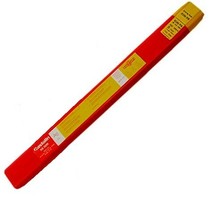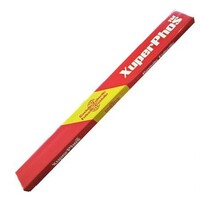Cu-P, or copper (Cu) - phosphorus (P) soldering
This is brazing with phosphorus as the flux element. Thanks to phosphorus, it is not necessary to use flux for joints where copper is joined to copper or a copper alloy. On the other hand, flux is never a disadvantage; on the contrary, it helps to ensure that the soldering process runs smoothly. The processes that require flux are joints where brass and bronze are soldered. A flux specially developed for CuP soldering is Cu Flux 5000FX.
The flowability of the solder depends on the phosphorus and silver content of the solder. CuP solder is divided into silver-free and silver-containing solder.
Silver-free solder is available in the alloys Cu+P6, Cu+P7, Cu+P8. The higher the phosphorus content of the solder, the better the creep resistance. At first glance, one could say that phosphorus replaces silver, which is true, but at the expense of brittleness. Joints soldered with high-phosphorus solder are brittle and cannot be exposed to temperature fluctuations and vibrations. For joints that are exposed to high temperature fluctuations and vibrations, Cu-P solder with silver content is recommended. CuPAg2, CuPAg5, CuPAg15, CuPAg18 are generally available.
Copper-phosphorus soldering, also known as copper-phosphorus alloy soldering, is a widely used method of joining copper and copper alloy components in various industries. This brazing technique uses a copper-phosphorus alloy solder, which usually contains a small percentage of phosphorus, to create strong and durable joints.
Brazing is a process of joining metal parts by melting a filler metal with a lower melting point than the base metals. In copper-phosphorus brazing, the brazing alloy is usually placed between the copper surfaces to be joined in the form of rods, wires or preforms. The solder joint is then heated to a temperature above the melting point of the filler metal but below the melting point of the base metals.
The most important advantages of copper-phosphorus soldering include
Compatibility with copper and copper alloys: Copper-phosphorus brazing is specifically designed for joining copper and copper alloy components. It offers excellent wetting and bonding properties, resulting in strong and reliable joints.
Low melting point: Copper-phosphorus solders have relatively low melting points compared to base metals, which helps to minimize thermal stress and distortion of the components being joined.
Self-flowing properties: The phosphorus content in the solder acts as a flux and reduces the need for additional flux during the soldering process. This simplifies the soldering process and eliminates the need for cleaning after soldering.
Corrosion resistance: Copper-phosphorus solder joints have good corrosion resistance due to the inherent corrosion resistance of copper and the protective oxide layer formed during the soldering process.
It is important to note that proper brazing techniques, including joint design, surface preparation and heating profiles, should be followed to ensure successful brazed joints. In addition, the selection of the appropriate copper-phosphorus filler material composition and form is critical to achieve the desired mechanical and metallurgical properties of the brazed joints.
Overall, copper-phosphorus brazing is a reliable and widely used method for joining copper and copper alloy components, providing strong, durable and corrosion-resistant joints in various applications.
Copper-phosphorus brazing is often used in applications that require high strength and corrosion resistance. For example, it is often used in the automotive industry to join copper pipes and fittings.
Copper-phosphorus brazing can be carried out using various methods, e.g. torch brazing, furnace brazing and induction brazing.
When selecting a filler metal for copper-phosphorus brazing, it is important to consider the type of copper to be joined, the temperature range and the desired properties of the joint. It is also important to use a flux that is compatible with the solder and the copper to be joined.


